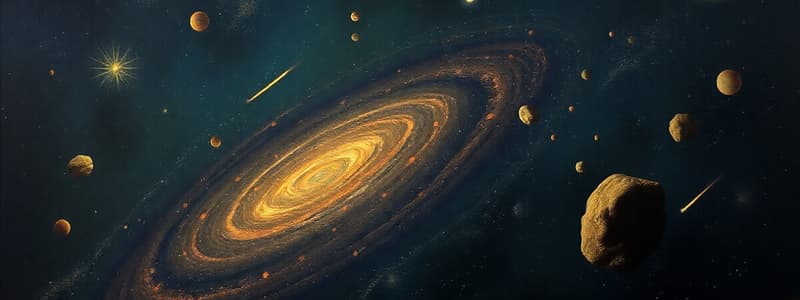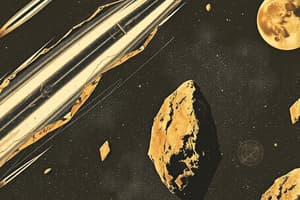Podcast
Questions and Answers
What distinguishes the composition of C-type asteroids from S-type and M-type asteroids?
What distinguishes the composition of C-type asteroids from S-type and M-type asteroids?
- C-type asteroids lack any metallic elements.
- C-type asteroids are primarily made of iron and nickel.
- C-type asteroids are composed mostly of silicates.
- C-type asteroids are dark in color and rich in carbon. (correct)
Which orbital characteristic is associated with long-period comets?
Which orbital characteristic is associated with long-period comets?
- They have near-circular orbits.
- They take more than 200 years to complete an orbit. (correct)
- They are tied to the gravitational pull of Jupiter.
- They follow a parabolic path to the sun.
What is the primary component that gives meteoroids their weight compared to their size?
What is the primary component that gives meteoroids their weight compared to their size?
- Density varies significantly due to the presence of heavy metals. (correct)
- Silicon and oxygen primarily contribute to their mass.
- They are large in size and contain primarily gas.
- Meteoroids consist mainly of frozen gases, making them lighter.
What causes a meteor to appear as a bright streak of light in the sky?
What causes a meteor to appear as a bright streak of light in the sky?
What defines the main difference between a meteoroid and a meteorite?
What defines the main difference between a meteoroid and a meteorite?
Which of the following best describes the origin of most comets?
Which of the following best describes the origin of most comets?
What is the key difference between the nucleus of a comet and the body of an asteroid?
What is the key difference between the nucleus of a comet and the body of an asteroid?
Which of the following features best describes a meteor's journey through Earth's atmosphere?
Which of the following features best describes a meteor's journey through Earth's atmosphere?
How are meteoroids primarily formed?
How are meteoroids primarily formed?
What is commonly referred to as a 'dirty snowball' in astronomy?
What is commonly referred to as a 'dirty snowball' in astronomy?
What is the primary origin of a meteorite?
What is the primary origin of a meteorite?
Which of the following materials primarily composes meteorites?
Which of the following materials primarily composes meteorites?
What distinct feature often characterizes a meteorite?
What distinct feature often characterizes a meteorite?
What is the orbital status of a meteorite after it lands?
What is the orbital status of a meteorite after it lands?
Which of the following best describes the relationship between meteors and meteorites?
Which of the following best describes the relationship between meteors and meteorites?
What distinguishes meteorites from asteroids?
What distinguishes meteorites from asteroids?
Which type of celestial body is primarily composed of icy nuclei and can develop tails near the Sun?
Which type of celestial body is primarily composed of icy nuclei and can develop tails near the Sun?
What is a common misconception about meteoroids?
What is a common misconception about meteoroids?
Which of the following statements is true regarding comet origins?
Which of the following statements is true regarding comet origins?
Which definition best describes the term 'meteoroid'?
Which definition best describes the term 'meteoroid'?
Flashcards are hidden until you start studying
Study Notes
Asteroids
- Leftover materials from the formation of the solar system or failed planetary formations.
- Primarily found in the Asteroid Belt between Mars and Jupiter, but some are near-Earth asteroids.
- Composed of rock.
- C-type (Carbonaceous): dark in color, high in carbon.
- S-type (Silicaceous): light-colored, composed of silicates.
- M-type (Metallic): bright, made of iron and nickel.
- Some asteroids are in near-Earth orbits, while others are Trojan asteroids located near Jupiter's orbit.
- Irregularly shaped and come in various colors based on their composition.
Comets
- Originate from the Oort Cloud and the Kuiper Belt, regions of icy bodies.
- Made of ice, frozen gas, rocks, and dust.
- Have a coma (a cloud of gas and dust) and two tails:
- Dust tail, composed of dust particles.
- Ion tail, composed of charged gas particles.
- Commonly referred to as a “dirty snowball."
- Most comets follow elliptical and eccentric orbits.
- Short-period comets: complete their orbits in less than 200 years.
- Long-period comets: take more than 200 years to orbit the Sun.
- The coma and tails develop when a comet is close to the Sun, making them visible.
Meteoroids
- Small pieces of debris from disintegrated comets or asteroids.
- Vary from dense metallic meteoroids to lighter, more fragile stony meteoroids.
- Composed of silicon, oxygen, nickel, and iron.
- Drawn towards Earth by gravity.
- Small, irregularly shaped rock fragments ranging in size from dust particles to small rocks.
Meteors
- A meteoroid that has entered Earth’s atmosphere.
- Appears as a bright streak of light called a shooting star or falling star.
- Burning up in the atmosphere due to friction, creating the visible light.
Meteorites
- A meteor that survives its fiery descent and hits the Earth's surface.
- Often have a burned or shiny exterior from their passage through the atmosphere.
- Resemble Earth rocks, but with a burned or melted outer layer.
Studying That Suits You
Use AI to generate personalized quizzes and flashcards to suit your learning preferences.




